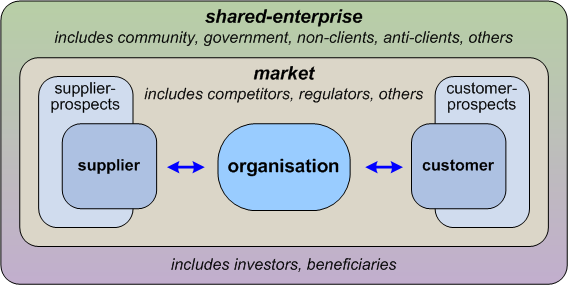Link: http://weblog.tetradian.com/2013/12/02/a-kind-of-manifesto-short/
Enterprise-architecture is dead; long live the architecture of the enterprise? Or something like that, anyway…
Time for a kind of manifesto, I guess?
As is perhaps too usual in my writing, the full-length version of the ‘manifesto’ ended up, uh, kinda long… So here’s a short-form summary, consisting only of the highlighted statements in that ‘manifesto’: if you need more detail, refer back to the full-length version.
One point I perhaps first need to clarify: By ‘enterprise‘ (or ‘shared-enterprise’) here I do not mean the organisation-as-enterprise, but something several orders-of-magnitude larger – that which the organisation chooses (if only by default) to orbit:
Anyway, on with the show:
– We create an architecture for an organisation, about a broader shared-enterprise.
– The shared-enterprise is not, and never can be, under our organisation’s control.
– Recursion is an inherent part of the picture here, at every scale.
– In a viable architecture of the enterprise, everywhere and nowhere is ‘the centre’, all at the same time.
– The shared-enterprise is perhaps best-understood as an ‘ecosystem-with-purpose’.
– Everything within the shared-enterprise depends on everything else.
– No item in the enterprise is inherently ‘more important’ or ‘less important’ than any other.
– The purpose and reason for ‘the architecture of the enterprise’: that things work better when they work together, on purpose.
– People and their needs are the ultimate start-point and end-point of all concerns in the shared-enterprise.
– Technology is only ever an enabler – never ‘the sole centre’.
– We must always place people first in the enterprise – not the technology.
– We need to rethink how work itself is organised, within the organisation and beyond.
– Volatility, uncertainty, complexity and ambiguity are characteristics that every architecture must address.
– The architecture of the enterprise is inherently contextual.
– Architecture sits at the intersection of structure and story.
– Architectural methods should support and be applied to the enterprise of ‘the architecture of the enterprise’ itself.
– Work for the architecture of the enterprise takes place over multiple, overlapping timescales.
Next: what does this mean in practice? – perhaps especially for my own future work?
Watch This Space, I’d suggest? ![]()
